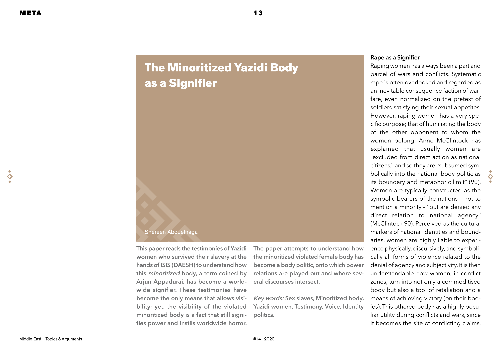The Minoritized Yazidi Body as a Signifier
This paper reads the testimonies of Yazidi women who survived their slavery at the hands of ISIS (DAESH) to understand how this ‘minoritized’ body, a term coined by Arjun Appadurai, has become a worldwide signifier. Due to the circulation of images and technologies, the testimonies of those women wh...
I tiakina i:
| I whakaputaina i: | Middle East - Topics & Arguments |
|---|---|
| Kaituhi matua: | |
| Hōputu: | Artikel (Zeitschrift) |
| Reo: | Ingarihi |
| I whakaputaina: |
Philipps-Universität Marburg
2020
|
| Ngā marau: | |
| Urunga tuihono: | Urunga tuihono |
| Ngā Tūtohu: |
Kāore He Tūtohu, Me noho koe te mea tuatahi ki te tūtohu i tēnei pūkete!
|
| Whakarāpopototanga: | This paper reads the testimonies of Yazidi women who survived their slavery at the hands of ISIS (DAESH) to understand how this ‘minoritized’ body, a term coined by Arjun Appadurai, has become a worldwide signifier. Due to the circulation of images and technologies, the testimonies of those women who survived have become the only means that allows visibility; yet, the visibility of the violated minoritized body is a fact that still signifies power and instills worldwide horror. The paper attempts to understand how the minoritized individual body has become a body politic, onto which power relations are played out and where several discourses intersect. |
|---|---|
| DOI: | 10.17192/meta.2020.14.8257 |
